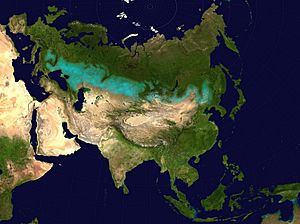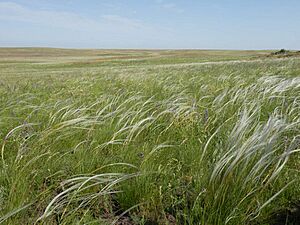Eurasian Steppe facts for kids
The Eurasian Steppe is a huge area of grasslands in northern Eurasia. Think of it as a giant, flat, grassy highway stretching across continents! It goes all the way from Eastern Europe, through Russia and Kazakhstan, and into Mongolia and northern China. It's located just south of Siberia.
For thousands of years, nomads (people who move from place to place) lived and traveled across this steppe. They often rode horses. In fact, many historians believe that horses were first tamed right here in the steppe, perhaps in the area we now call Kazakhstan. Horses made the steppe a super important route, helping people and ideas travel between China and Europe. This is why it became a key part of the famous Silk Road, an ancient trade network.
Many powerful empires and groups have controlled parts of the steppe throughout history. These include the Xiongnu, Scythians, the Han dynasty, the Mongol Empire, and the Russian Empire. Each group left its mark on this vast land.
Contents
Life on the Steppe
Nomadic Way of Life
For a very long time, the Eurasian Steppe was home to nomadic groups. These people didn't live in one fixed place. Instead, they moved around with their herds of animals, like horses, sheep, and goats. They lived in portable homes, such as yurts, which could be easily packed up and moved.
Their lives depended on their animals and the grasslands. They would move to find fresh pastures for their herds. This way of life made them very skilled riders and warriors. They were always ready to travel and adapt to new places.
The Horse's Importance
The horse was incredibly important to the people of the steppe. It was more than just an animal; it was a partner in life. Horses provided transport, helped with hunting, and were even used in battles. They allowed nomads to travel vast distances quickly.
Some experts believe that horses were first tamed and ridden in the steppe region, possibly around modern-day Kazakhstan. This changed everything for the people living there. It made the steppe a super-fast "highway" for people, goods, and ideas to move between Asia and Europe.
The Silk Road Connection
Because of the horses and the open land, the Eurasian Steppe became a vital part of the Silk Road. This was not just one road, but a network of trade routes connecting the East and West. Goods like silk, spices, and precious metals traveled along these routes.
But it wasn't just goods that moved. Ideas, cultures, and technologies also spread across the steppe. This made the steppe a place where different civilizations met and exchanged knowledge.
Empires and Rulers
Early Steppe Empires
The steppe was a place where many powerful groups rose and fell. One of the earliest known groups were the Scythians. They were fierce warriors and skilled horse riders who lived in the western part of the steppe.
Later, the Xiongnu formed a large empire in the eastern steppe. They were a major challenge to the early Chinese dynasties. These early empires showed how strong and organized nomadic groups could become.
The Mongol Empire
Perhaps the most famous empire to come from the steppe was the Mongol Empire. Led by Genghis Khan in the 13th century, the Mongols created one of the largest empires in history. They used their amazing horse-riding skills and military tactics to conquer vast lands.
The Mongol Empire stretched from Eastern Europe all the way to East Asia. Their rule had a huge impact on the history of many countries. Even after the main empire split, parts of it, like the Golden Horde, continued to rule large areas of the steppe.
Later Empires
Over time, other powerful empires also came to control parts of the steppe. The Russian Empire slowly expanded eastward, taking over large sections of the northern steppe. The Qing dynasty in China also extended its control into the eastern steppe regions.
These empires often built forts and towns, slowly changing the nomadic way of life in some areas. However, the spirit of the steppe, with its wide-open spaces and history of movement, remained strong.
Steppe Environment
What is a Steppe?
A steppe is a type of grassland ecosystem. This means it's a large area mostly covered by grasses, with very few trees. Steppes usually have a dry climate, with hot summers and cold winters.
The soil in steppes is often very fertile, which is great for growing grasses. This also makes it good for farming, especially in areas where people have started to cultivate the land.
Flora and Fauna of the Steppe
The Eurasian Steppe is home to many unique plants and animals. The main plants are different types of grasses, which can grow tall or short depending on the area. These grasses are perfect for grazing animals.
Some of the cool animals you might find here include the speedy Saiga antelope, with its unique nose, and the clever Corsac fox. You might also see wild horses, like the Przewalski's horse, which is a rare and ancient type of horse. These animals are well-adapted to living in open, grassy environments.
Challenges for the Steppe
The steppe environment faces some challenges. Wildfires can happen, especially during dry seasons. Also, human activities like farming and building cities can change the natural grasslands.
It's important to protect these unique ecosystems. They are home to many special plants and animals, and they hold a rich history of human civilization.
Images for kids
-
Mongolian yurt
-
Plowing with tractor on the Great Hungarian Plain (Alföld), Hungary
-
Territories of the Golden Horde under Öz Beg Khan.
-
Devínska Kobyla, Bratislava, Slovakia
-
The Pannonian steppe in Seewinkel, Austria
-
The Pannonian steppe in Devínska Kobyla, Bratislava, Slovakia
-
Danube-Auen National Park, Austria
-
The Pontic–Caspian steppe near Krynychne, Ukraine.
-
The Pontic–Caspian steppe in Henichesk, Ukraine.
-
Steppes in Gagauzia, Moldova.
-
Steppes in Gagauzia, Dezghingea, Moldova.
-
Wooded Ural Mountains of Beloretsky District, Russia.
-
The Bashkiriya National Park is situated in the southern end of the Ural Mountains, Russia.
-
The Bashkiriya National Park, Ural Mountains, Russia.
-
The Bashkiriya National Park, Ural Mountains, Russia.
-
The steppe in Akmola Region, Kazakhstan.
-
The steppes in Akmola Province, Kazakhstan.
-
The Kazakh Steppe in the Ayagoz District, Kazakhstan.
-
Uvs Lake Basin, Tuva Republic, Russia.
-
Dus-Khol lake, Tuva Republic, Russia.
-
The grassland in Tuva Republic, Russia.
-
Dus-Khol Lake, Tandinsky District, Tuva Republic, Russia.
-
The Mongolian-Manchurian grassland in the Khövsgöl Province, Mongolia.
-
Grass steppe in the Khövsgöl Province, Mongolia.
-
The Mongolian-Manchurian grassland in Inner Mongolia, China.
See also
 In Spanish: Estepa euroasiática para niños
In Spanish: Estepa euroasiática para niños




































